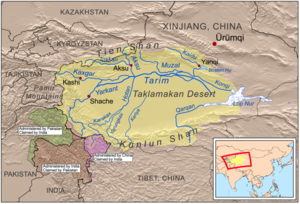Niya
| Author:Laxman Burdak, IFS (Retd.) |

Niya (नीया) was once a major commercial center on an oasis on the southern branch of the Silk Road in the southern Taklamakan Desert. During ancient times camel caravans would cut through, carrying goods from China to Central Asia.[1][2] It was part of Serindia.
The ruins of Niya
The ruins of Niya is an archaeological site located about 115 km north of modern Minfeng Town (also called Niya) on the southern edge of the Tarim Basin in modern-day Xinjiang, China. The ancient site was known in its native language as Cadota, and in Chinese during the Han Dynasty as Jingjue. Numerous ancient archaeological artifacts have been uncovered at the site.
History
Niya became part of Loulan Kingdom by the third century. Towards the end of the fourth century it was under Chinese suzerainty, later it was conquered by Tibet.[3]
Some archeological findings from the ruins of Niya are housed in the Tokyo National Museum. Others are part of the Stein collection in the British Museum, the British Library, and the National Museum in New Delhi.
In 1900, Aurel Stein set out on an expedition to western China and the Taklamakan Desert. In Niya he excavated several groups of dwellings, and found 100 wooden tablets written in 105 CE. These tablets bore clay seals, official orders and letters written in Kharoshthi, an early Indic script, dating them to the Kushan empire.[4][5]
Researchers have now found remains of human habitation including approximately 100 dwellings, burial areas, sheds for animals, orchards, gardens, and agricultural fields. They have also found in the dwellings well-preserved tools such as iron axes and sickles, wooden clubs, pottery urns and jars of preserved crops. The human remains found there have led to speculation on the origins of these peoples.[8]
ऊपरला हिन्द
दलीप सिंह अहलावत[6] के अनुसार चीन के प्राचीन ग्रन्थों में तुखारिस्तान का नाम ‘ताहिआ’ लिखा है। ह्यू एन-त्सांग ने इस देश का वर्णन किया है कि इसके उत्तर में दरबन्त (बदख्शां के समीप), दक्षिण में हिन्दूकुश पर्वत, पश्चिम में पर्शिया (ईरान) और पूर्व में पामीर की पर्वतमाला थी। उस समय तुखारिस्तान बौद्धधर्म का महत्त्वपूर्ण केन्द्र था । ऋषिक तुषारों का धर्म बौद्ध और जीवन युद्धमय था।[7]
ऋषिक-तुषारों ने हूणों को हराकर मंगोलिया की ओर भगा दिया और पूर्व की ओर बहुत बड़े क्षेत्र पर अधिकार कर लिया। उनकी इस विशाल भूमि का नाम सरिन्दिया (Ser-India) पड़ा, जिसको हिन्दी में ‘ऊपरला हिन्द’ कहा जाता है।[8]
यह ऊपरला हिन्द पश्चिमी बदख्शां से आरम्भ होकर पूर्व में लोपनोर झील तथा गोबी के मरुस्थल तक विस्तृत था। इस क्षेत्र के नगरों के अवशेष इस समय काशगर, यारकन्द, नीया, खोतन, कुचि आदि में उपलब्ध हुए हैं। इनसे यह भलीभांति प्रमाणित हो जाता है कि राजनैतिक दृष्टि से भारत के अन्तर्गत न होते हुए भी ये सब भारतीय सभ्यता के केन्द्र थे। इस तुखारिस्तान में ऋषिक-तुषारों ने अपने अनेक राज्य कायम किए। आगे चलकर कुषाण वंश के राजाओं ने जिन्हें जीतकर अपने अधीन कर लिया और एक शक्तिशाली व सुविस्तृत साम्राज्य की स्थापना की। पांचवीं सदी तक तुखारिस्तान कुषाणों के शासन में रहा। [9]
रामायणकाल में ऋषिकों का राज्य था और महाभारत एवं पुराणों के लेख अनुसार ऋषिक व तुषार वंश महाभारतकाल में अपने पूरे वैभव पर थे, ये लोग महाभारत युद्ध में लड़े थे। सम्राट् कनिष्क कुषाणगोत्री जाट के शासनकाल में ऋषिकवंशी महात्मा लल्ल ने इन चन्द्रवंशी ऋषिक व तुषार जाटों के संघों का संगठन कर दिया जिनसे इनका नाम गठवाला पड़ गया। इनका पूज्य पुरुष लल्ल ऋषि था और पदवी मलिक हुई जिससे इनका पूरा नाम लल्ल गठवाला मलिक है। (पूरी जानकारी के लिए देखो तृतीय अध्याय, ऋषिक-तुषार मलिक प्रकरण)।
चीन के उत्तर में विशाल दीवार बनने के बाद, हूण लोग अब चीन के पश्चिम के उन प्रदेशों में आ बसे थे, जहां पहले ऋषिकों (युइशियों) का निवास था। ये लोग समय-समय पर पश्चिम की ओर से आक्रमण करते रहते थे; जिनका सामना करना चीन के लिए कठिन था। इस दशा में चीन के सम्राट् वू-ती (142-85 ई० पू०) ने अपने सेनापति चाङ्-कियन को 138 ईस्वी पूर्व में हूणों के विरुद्ध सहयोग प्राप्त करने के लिये ऋषिक-तुषारों के पास भेजा। उस समय इन लोगों का शासन तुखारिस्तान पर था। चाङ्-कियन को हूणों ने मार्ग में ही पकड़ लिया और उसे 10 वर्ष तक अपनी कैद में रखा। कैद से छूटकर वह सिर दरिया के दक्षिण में स्थित खोकन्द पहुंचा, और वहां से समरकन्द होता हुआ बल्ख (बैक्ट्रिया) आ गया जो उस समय ऋषिक-तुषारों के शासन में था। चाङ्-कियन ने उनसे हूणों के विरुद्ध सहयोग की याचना की। अतः ऋषिक-तुषारों ने हूणों पर पश्चिम की ओर से पुरजोर आक्रमण आरम्भ कर दिया तथा चीन ने हूणों पर पूर्व की ओर से
जाट वीरों का इतिहास: दलीप सिंह अहलावत, पृष्ठान्त-328
दबाव डाला। ये आक्रमण 127 ई० पू० से 119 ई० पू० तक होते रहे। अन्त में हूणों को परास्त करके चीन की पश्चिमी सीमा से उत्तर में मंगोलिया की ओर खदेड़ दिया। चीन-भारत की मैत्री का यह पहला अवसर माना जाता है।[10]
References
- ↑ Boulnois, Luce (2005). Silk Road: Monks, Warriors & Merchants. Hong Kong: Odessey Books & Guides. pp. 458, 501. ISBN 962-217-721-2.
- ↑ "The Most Important Findings of Niya in Taklamakan". The Silk Road.
- ↑ Susan Whitfield (2004). "Krorain: Settlements in the Desert (Niya and the Oases of Kroraina)". The Silk Road: Trade, Travel, War and Faith. The British Library. ISBN 1-932476-12-1
- ↑ An Archeologist Follows His Dreams to Asia
- ↑ The Silk Road Finds
- ↑ जाट वीरों का इतिहास: दलीप सिंह अहलावत, पृष्ठ-328,329
- ↑ मध्य एशिया तथा चीन में भारतीय संस्कृति, पृ० 12, 78-79, 108-109,
- ↑ मध्य एशिया तथा चीन में भारतीय संस्कृति, पृ० 12, 78-79, 108-109,
- ↑ जाटों का उत्कर्ष, पृ० 332, लेखक योगेन्द्रपाल शास्त्री।
- ↑ मध्य एशिया तथा चीन में भारतीय संस्कृति, पृ० 79, लेखक सत्यकेतु विद्यालंकार, जाटों का उत्कर्ष पृ० 332, लेखक योगेन्द्रपाल शास्त्री, जाटवीरों का इतिहास, तृतीय अध्याय, ऋषिक-तुषार प्रकरण।